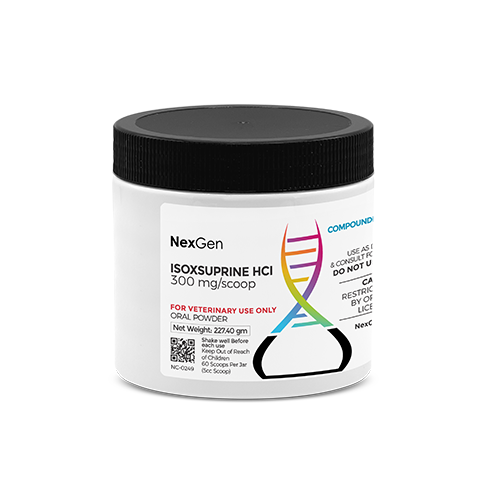
Isoxsuprine HCl 300 mg/scoop, Oral Powder, 60 Scoops (5cc Scoop)
Login for pricing
- Brand
- Mixlab
- SKU:
- NC-0249
- Product Type:
- Powder
- Size:
- 16oz
- Administration:
- Oral
- Scoops Per Container:
- 60
- Scoop Size:
- 5cc
Navicular disease (also known as navicular syndrome) in horses is the result of inflammation or degeneration of the navicular bone and its surrounding tissues, which usually occurs in the front feet of the horse.1 The condition most often leads to significant and even disabling lameness. Diagnosis and treatment of navicular disease is often confounded by its typically slow and/or intermittent onset.
The navicular bone is located between the pedal bone and the deep digital flexor tendon at the top portion of the hoof. Since the hoof structures associated with navicular disease usually include similar characteristics (long toes, under-run heels, and a “broken back” hoof-pastern axis), the condition is believed to be genetic, but can come about due to the conformation of the distal limbs.2 Navicular syndrome is more common in riding horses between the age of 8 and 10 years old and is generally associated with breeds such as Warmbloods, Quarter horses, and Thoroughbreds.3
Symptoms, Progression and Diagnosis
While the cause of navicular disease is not certain, the available literature suggests that damage to the navicular bone may occur due to limited blood supply or trauma to the navicular bone itself.2,3 Pain and lameness is also thought to occur as a result of damage to the deep flexor tendon, navicular bursa, or navicular ligaments. When a horse develops navicular disease, they will typically present with a low grade bilateral lameness. Another sign is head-bobbing, especially when trotting.1 As mentioned above, since the progression of this condition is slow, lameness may be intermittent. Navicular syndrome does not always occur in both hooves, and it can be more pronounced in one foot than the other.
A definitive diagnosis of navicular syndrome is obtained by an examination of the horse’s history, genetic profile and observing its movement. An additional method is the use of nerve blocks. This involves the injection of a local anesthetic around the nerves on the posterior area of the foot that surrounds the navicular bone.2 If the anesthetic is applied and lameness improves, it is likely that the horse is suffering from navicular disease. Nerve blocking the coffin joint is also a good indicator, as this tends to improve lameness in horses with this condition as well.3
Isoxsuprine for Navicular Disease in Horses
After parenteral administration, horses may show short-lived signs of CNS stimulation (uneasiness, hyperexcitability, nose-rubbing), tachycardia, and increased cardiac output, or sweating. Adverse effects are unlikely after oral administration but hypotension, tachycardia, and GI effects are possible.1
Where to buy Isoxsuprine
Isoxsuprine is available in the U.S. through several pharmaceutical manufacturers and through veterinary custom compounding companies.
Please consult your veterinarian prior to beginning any treatment regimen.
FOR RX ONLY: A valid prescription from a licensed veterinarian is required for dispensing this medication.
1Merck Veterinary Manual.


















